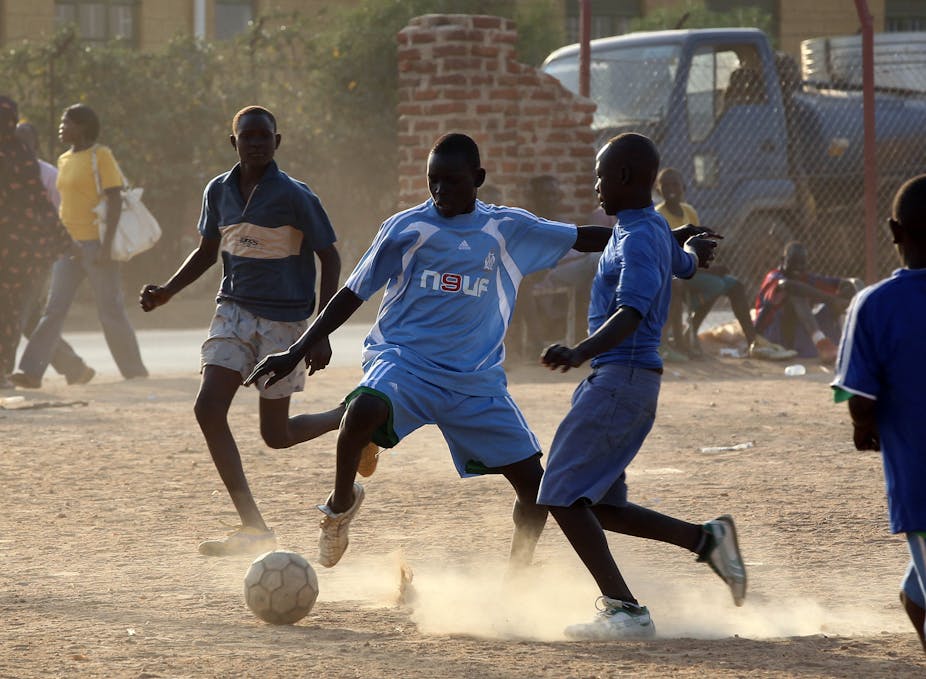On July 9, 2011, South Sudan seceded from Sudan to become the world’s newest nation. That weekend, its new national football team played a match in the capital Juba. Within months, the Confederation of African Football granted the squad provisional membership, and in July 2013 President Salva Kiir named the team Bright Star. Emphasising the importance of unity as a necessary element for national development, Kiir opined that sports should be encouraged to promote that goal.
While the team may be in its adolescence, Sudanese football is a vestige of the country’s colonial past stretching between 1899 and 1956 in what was known as the Anglo-Egyptian Condominium. My recently published journal article explores this history, and examines how the game was linked with various ethnic, religious and political projects.
South Sudan has been through a tumultuous time since 2011 independence. Understanding the game’s early influences can help shed light on the current context. These insights are as enlightening as they are discouraging.
Football in colonial Sudan
In the early 20th century, football in what is today Sudan was played at Khartoum’s elite Gordon Memorial College. Gordon played annual matches against the Khartoum Military School. Sudan’s oldest football stadium was built in Atbara in 1927, and the Sudan Football Association was established in the 1930s. The number of clubs quickly rose from 36 in the 1936-1937 season to 103 in 1945-1946.
In Southern Sudan, the growth of football was linked with Christian missionaries who entered the South in the early 1900s following the destruction of the Mahdist regime. Football was played at the Church Missionary Society’s first Southern mission site at Malek and at Yei, where African and non-African participants competed.
The Nugent missionary school was the king of Southern football during the colonial years. An elite and multi-ethnic intermediate school, the pitch became a site where inter-ethnic competition was encouraged.
Sudan, still jointly ruled at this point by Britain and Egypt, joined FIFA in 1948. This was years ahead of its independence – which came in 1956 – and membership in the United Nations and Arab League. Six years later it discussed a plan with Egypt, Ethiopia, and South Africa for an African confederation during the FIFA Congress in Bern.
Sudan’s early independence years were marred by civil war between Southern rebels and the Northern-based government. Political power had been centred in Khartoum during the colonial era. During the early independence years the government sought to fashion the country as an Arab and Islamic state. Southerners rebelled and a state of war persisted until 1972.
Interestingly enough, the war years corresponded with the golden age of Sudanese football. Sudan hosted the first African Nations Cup, were runners-up in 1959 and 1963, and won it all against Ghana in 1970.
Post-independence Sudan and Football’s Possible Meaning
Conflict resumed in 1983 following President Jafaar Nimeiri’s decision to institute Sharia throughout the country. While the John Garang-led Sudan Peoples’ Liberation Army/Movement led the war against Khartoum, Southerners were also embroiled in internal ethnic conflict. The most infamous of these conflicts occurred between the largest ethnic groups, the Dinka and the Nuer.
The 2005 Comprehensive Peace Agreement ended formal hostilities and a referendum ushered in independence for the South. But ethnic factionalism persisted and erupted into a new civil conflict in December 2013. The main combatants were groups loyal to Riek Machar (a Nuer) and President Kiir (a Dinka). After a host of failed cessation agreements, both men recently agreed to a new peace agreement that reinstates Machar as vice president.
To what extent, then, has football shaped the present context? How might Sudan’s footballing past inform South Sudan’s present and future?
Sport as a unifier
One easy answer is that the sport will be a much-needed unifier. At the multi-ethnic Nugent School, the pitch was a space in which people from varying ethnicities could compete in the same space, according to the same rules, with the same objectives in mind.
The national team’s composition and the encouragement of a national league with players, fans, and officials of diverse ethnicities could convey the important political message that unity is possible in one of Africa’s most fragmented states.
But Sudanese football history also suggests that expectations should be tempered. Nugent School football wasn’t always peaceful. One contentious match between Azande and Dinka squads saw a British referee line both teams up and inflict corporal punishment to encourage them to behave. In addition, although players of multiple ethnicities competed with one another, the teams were still divided along ethnic lines.
Despite this, it’s useful to consider that the Sudanese national team during its early post-colonial years enjoyed great success despite the regional maelstrom then wracking the country. This shows that winning on the pitch did not reflect unity or success off the pitch.
African football’s political capital
In today’s Southern Sudanese political climate, success in the next African Cup of Nations or — if one can dare to dream — qualifying for the 2022 Qatar World Cup may wield more symbolic importance than anything else. If the last 30 years are any indication, it will not make Machar and Kiir any more likely to put aside their personal and political differences; differences that have so often resulted in bloodshed.
And yet, there are obvious examples of sport’s capacity to rally African nations together (if at least temporarily). The ‘Invictus’ rugby team during Mandela’s presidency, the stoppage in Ivory Coast’s civil war during its team’s World Cup run, and the recent election of Liberian football legend George Weah as president are some examples that speak to African football’s political capital.
Whether the Bright Star comes to represent a shining light for the young, war-torn nation remains to be seen.

